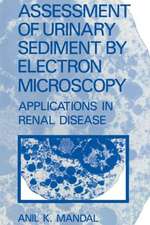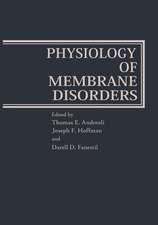Uremic Toxins and Organ Failure
Editat de Hideyuki Saito, Takaaki Abeen Limba Engleză Paperback – 14 oct 2021
| Toate formatele și edițiile | Preț | Express |
|---|---|---|
| Paperback (1) | 638.02 lei 38-44 zile | |
| Springer Nature Singapore – 14 oct 2021 | 638.02 lei 38-44 zile | |
| Hardback (1) | 715.35 lei 3-5 săpt. | |
| Springer Nature Singapore – 13 oct 2020 | 715.35 lei 3-5 săpt. |
Preț: 638.02 lei
Preț vechi: 671.60 lei
-5% Nou
122.10€ • 126.75$ • 101.81£
Carte tipărită la comandă
Livrare economică 18-24 martie
Specificații
ISBN-10: 9811577951
Pagini: 180
Ilustrații: VIII, 180 p. 39 illus., 22 illus. in color.
Dimensiuni: 155 x 235 mm
Ediția:1st ed. 2020
Editura: Springer Nature Singapore
Colecția Springer
Locul publicării:Singapore, Singapore
Cuprins
Introduction 1 Overview of Uremic Toxins 2 Review: Uremic toxins and gut microbiome 3 Gut microbiota and systemic uremic solute accumulation 4 Uremic toxin-related systemic disorders 5 Uremic Toxins and cardiovascular disease 6 Indoxyl sulfate and arteriosclerosis 7 Uremic Toxicity and Bone in CKD 8 D-serine as a novel uremic toxin 9 Uremic solutes and sarcopenia 10 Toxico-pathological role of hepatic sulfotransferase (SULT) 1A1 in acute kidney injuries 11 Accumulation of uremic toxins in systemic organs and the effect of AST-120
Notă biografică
Hideyuki Saito
Department of Pharmacy, Kumamoto University Hospital & Department of Clinical Pharmaceutical Sciences, Kumamoto University Graduate School of Life Sciences, Kumamoto University
Honjo, Chuo-ku, Kumamoto, Japan
Email: saitohide@kuh.kumamoto-u.ac.jp
Takaaki Abe
Division of Nephrology, Endocrinology, and Vascular Medicine, Department of Medicine
Tohoku University Graduate School of Medicine
Seiryo-cho, Aoba-ku, Sendai, Japan
Email: takaabe@med.tohoku.ac.jp
Textul de pe ultima copertă
This book describes the latest research on the gut-kidney axis of ureic solutes; the toxico-pathological mechanisms of uremic toxin-induced organ failure, including kidney and cardiovascular tissue; and the preventive therapeutic strategies for uremia and related organ failure associated with kidney injuries and diseases. Retained uremic toxins cause a variety of symptoms, such as hypertension, fatigue, renal anemia, osteoporosis and neurologic impairment, which are apparent in chronic kidney disease (CKD) patients. The human gastrointestinal tract contains trillions of microorganisms, referred to as gut microbiota, which support the host metabolism by producing nutrients, such as vitamins and short-chain fatty acids. However, they also produce various harmful uremic toxins that show renal and cardiovascular toxicity, and correlate with an increased mortality in CKD patients. The composition and balance of gut microbiota are associated with the accumulation of uremic toxins and the pathophysiology of CKD, and as such are being considered for a novel therapeutic strategy.
Caracteristici
Presents the latest research on the gut-kidney axis
Describes a new therapeutic strategy for CKD
Includes special chapters in indoxyl sulfate, ADMA, Sulfotransferase 1A1, and D-serine
Descriere
This book describes the latest research on the gut-kidney axis of ureic solutes; the toxico-pathological mechanisms of uremic toxin-induced organ failure, including kidney and cardiovascular tissue; and the preventive therapeutic strategies for uremia and related organ failure associated with kidney injuries and diseases. Retained uremic toxins cause a variety of symptoms, such as hypertension, fatigue, renal anemia, osteoporosis and neurologic impairment, which are apparent in chronic kidney disease (CKD) patients. The human gastrointestinal tract contains trillions of microorganisms, referred to as gut microbiota, which support the host metabolism by producing nutrients, such as vitamins and short-chain fatty acids. However, they also produce various harmful uremic toxins that show renal and cardiovascular toxicity, and correlate with an increased mortality in CKD patients. The composition and balance of gut microbiota are associated with the accumulation of uremic toxins and the pathophysiology of CKD, and as such are being considered for a novel therapeutic strategy.


























